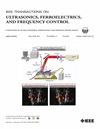Study of the Impact of Probe Steering Capability on the Performance of Off-Axis Measurements of Backscattered Signals
IF 3
2区 工程技术
Q1 ACOUSTICS
IEEE transactions on ultrasonics, ferroelectrics, and frequency control
Pub Date : 2024-12-19
DOI:10.1109/TUFFC.2024.3519194
引用次数: 0
Abstract
In the field of quantitative ultrasound (QUS), several studies have been conducted to parameterize tissue anisotropy by measuring the angular dependence of the backscatter coefficient (BSC). Early foundational studies utilized a single-element transducer, and more recent ones used ultrasound linear array probes. However, probe features such as directivity and crosstalk can strongly affect both, the transmission of an ultrasound beam and the measurements of the backscattered signals, independent of the imaging strategy used, either the focused beam steering or the plane wave imaging (PWI). In this work, we present a comparative analysis between a capacitive micromachined ultrasonic transducer (CMUT) probe and a commercial piezoelectric probe, in which the BSC is measured using the focused beam steering imaging strategy on isotropic and anisotropic tissue-mimicking phantoms along different insonification angles. The results show how the limited steering capabilities of linear probes can affect the measurement of BSC, and, in general, the anisotropic QUS parameters, bringing into discussion their consideration in the development of experimental strategies for the assessment of tissue anisotropy.探针转向能力对背向散射信号离轴测量性能影响的研究
在定量超声(QUS)领域,通过测量后向散射系数(BSC)的角依赖性来参数化组织各向异性的研究已经开展。早期的基础研究使用单元件换能器,最近的研究使用超声线性阵列探针。然而,探针的特性,如指向性和串扰,会强烈影响超声波束的传输和后向散射信号的测量,而与使用的成像策略无关,无论是聚焦波束转向还是平面波成像(PWI)。在这项工作中,我们提出了电容式微机械超声换能器(CMUT)探头和商用压电探头之间的比较分析,其中BSC是使用聚焦光束导向成像策略在各向同性和各向异性组织模拟模型上沿着不同的失谐角度进行测量的。结果表明,线性探针的有限转向能力如何影响BSC的测量,以及总体上的各向异性QUS参数,并讨论了在制定评估组织各向异性的实验策略时应考虑的因素。
本文章由计算机程序翻译,如有差异,请以英文原文为准。
求助全文
约1分钟内获得全文
求助全文
来源期刊
CiteScore
7.70
自引率
16.70%
发文量
583
审稿时长
4.5 months
期刊介绍:
IEEE Transactions on Ultrasonics, Ferroelectrics and Frequency Control includes the theory, technology, materials, and applications relating to: (1) the generation, transmission, and detection of ultrasonic waves and related phenomena; (2) medical ultrasound, including hyperthermia, bioeffects, tissue characterization and imaging; (3) ferroelectric, piezoelectric, and piezomagnetic materials, including crystals, polycrystalline solids, films, polymers, and composites; (4) frequency control, timing and time distribution, including crystal oscillators and other means of classical frequency control, and atomic, molecular and laser frequency control standards. Areas of interest range from fundamental studies to the design and/or applications of devices and systems.

 求助内容:
求助内容: 应助结果提醒方式:
应助结果提醒方式:


